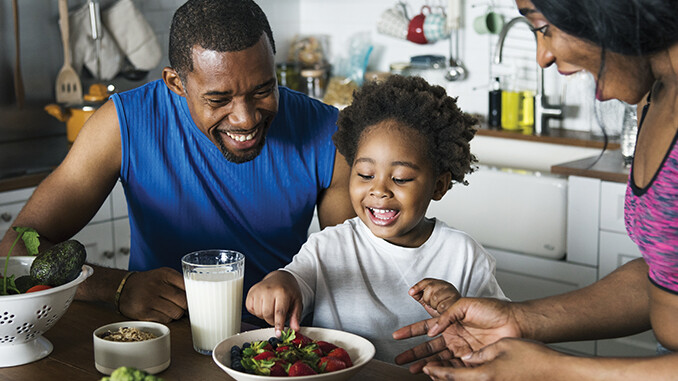
Helping your child create healthier eating habits is a recipe for long-term success
Published: December 31, 2021
By: Paige Townley
Another new year usually means new resolutions, and for many parents, included on that list is a resolution to help their children make healthier food choices. The task can be rather difficult – and daunting – especially if not-so-good eating habits have already been established. But don’t fret; positive changes can occur if the right steps are taken. Children’s of Alabama’s Clinical Nutritionist Janelle Schirmer gives us seven tips to help parents set the stage for healthy eating habits.
Take the Lead. One of the very first steps for parents in starting a new, healthier course of eating is understanding their responsibility with feeding. It’s about taking the lead role and establishing what a meal time will include and when it will be served. It also goes for snack times, too. “It is easy to let it be skewed so that the child runs the show in deciding when they are hungry and what they want to eat,” Schirmer says. “But parents need to remember they are in charge and a child’s responsibility is deciding if they are going to eat the meal and how much.”
Set Specific Times. Part of taking on the responsibility means setting a schedule and keeping to it as much as possible to prevent falling into the easy trap of allowing the child to graze on various foods all day long. “It’s an easy trap to fall in to, but setting specific times can help a child’s appetite when it comes to mealtime,” Schirmer adds. “That can also help them be more accepting of what they are being served because they have more internal regulation with their hunger cues.”
Don’t Cater to Preferences. At mealtimes it’s easy to focus exclusively on foods that you know your child likes, but it’s important to be mindful of introducing new, healthy foods too. A good rule of thumb Schirmer shares is when introducing a new food, include at least two other familiar foods the child likes on the plate too so it’s not overwhelming or intimidating. “They may be more willing to try a bite or two of the new food item if they know they like the other foods on the plate,” she says.
Be the Role Model. It’s hard to convince anyone to try something new if you aren’t trying it yourself, so it’s even more important for a child to see the parent eating healthy as well. “Parents have to be the role models,” Schirmer says. “If you aren’t willing to eat the fruits or vegetables, your child will mimic that behavior and they won’t even have the exposure to the food.”
Be Persistent. Chances are there won’t be tremendous success the first time a healthy food is introduced. But that’s normal, so parents shouldn’t give up. It’s important for parents to continue with the same healthy behaviors by eating the new food and continuing to expose the child to healthy eating. “It could also be that you just need to try preparing the food differently to change the texture,” Schirmer says. “A child may like carrots but prefer them raw instead of cooked or vice versa. Play around with the preparation to find a way that might be more appealing.”
Limit Junk Food. It almost goes without saying that parents should severely limit empty calorie foods in order to get in food with more nutrients. Children, especially younger children, have higher nutrient needs, especially with iron and calcium for growth and bone development. Children can only consume so many calories and foods in a day, and the more sugar-sweetened beverages or junk food, the less likely it will be that they get enough foods with the right nutrients.
Involve Them in the Process. Any food can feel more fun to a child if they had a hand in the process. Simple things such as letting a child help create the dinner menu, letting them select a particular fruit or vegetable at the grocery store, or helping prep or cook the food in the kitchen can turn a food they would typically turn down into one of their favorites on the plate. “Simple things like this might not sound like a big deal, but they really can make a difference,” Schirmer says. “When kids are involved, they feel a sense of ownership and are much more likely to want to try it. Another potential option is starting an at-home garden that allows them to even grow some of the produce that they will eventually see on their plate.”
Paige Townley is a Birmingham freelance writer.
